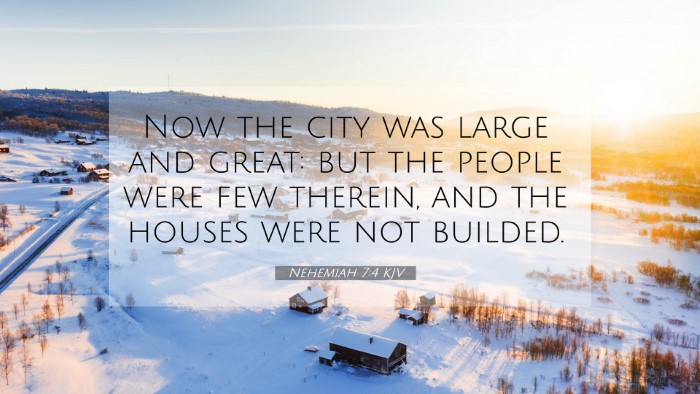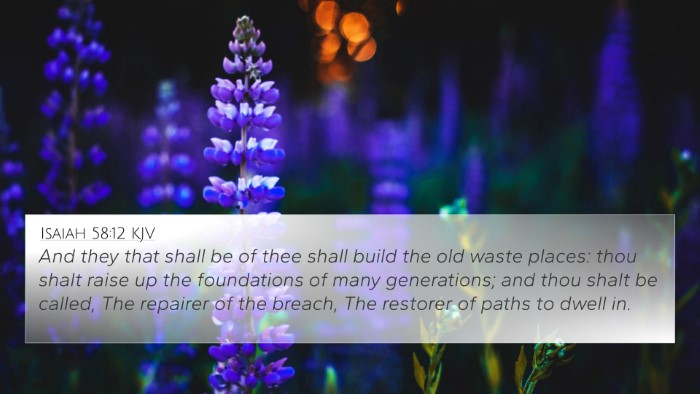Understanding Nehemiah 7:4
Nehemiah 7:4 states, "The city was wide and large, but the people in it were few, and the houses were not rebuilt." This verse encapsulates a significant moment in the post-exilic history of Israel, highlighting the challenges the returned exiles faced.
Summary of Key Insights
This verse indicates the physical state of Jerusalem after its destruction. Nehemiah, tasked with the reconstruction of the city, notes the vastness of the city contrasted with the "few" people inhabiting it and the absence of rebuilt houses. The passage serves multiple interpretative purposes:
- Physical Implications: The mention of the city's width and largeness signifies its past glory and God's intention to restore it.
- Spiritual Reflection: The sparse population reflects spiritual desolation — a reminder of the need for revival and growth in faith.
- Leadership Challenge: For Nehemiah, this presents a call to arms, to inspire and mobilize reinforcements to not only repopulate but refurbish the city.
Commentary Insights
Matthew Henry notes that the condition of Jerusalem leads us to contemplate the absence of divine presence amidst physical desolation. He emphasizes that while the city lies in ruins, the real issue is the hearts of the people needing rebuilding.
Albert Barnes focuses on Nehemiah's leadership, underscoring that effective governance requires an understanding of both the material and spiritual needs of the community. He stresses that Nehemiah's recognition of the empty houses signifies a broader neglect of God’s commandments by the people.
Adam Clarke highlights the theological implications, asserting that the city's emptiness signifies a transition period for Israel. The focus shifts from passive waiting to active rebuilding, which echoes the theme of regeneration frequently found throughout Hebrew Scripture.
Related Bible Verse Cross-References
- Ezra 2:64-65: Illustrates the number of exiles who returned to Jerusalem.
- Jeremiah 30:18: God promises restoration of cities; parallel in theme of hope.
- Isaiah 54:3: Speaking on enlargement; a reflection of God’s promise of growth.
- Haggai 1:4: A call to consider one's ways and work on rebuilding.
- Zechariah 1:17: Encouragement for God’s people to rebuild and flourish.
- Psalms 102:14: God's compassion towards Zion highlights the significance of Jerusalem.
- James 1:22: Calls for action in faith, linking to the reconstruction efforts by Nehemiah.
Connections with Other Scriptures
The context of Nehemiah 7:4 invites exploration of multiple Bible verse cross-references through the lens of restoration and revival. The narratives engage with themes of divine promise, human diligence, and spiritual awakening as follows:
- Linking Biblical texts: Incorporating Nehemiah's story alongside the messages of the Prophets reveals a continuous thread of divine engagement with His people.
- Comparative Bible verse analysis: Comparing calls for repentance in Amos 5:24 highlights the importance of genuine revival in the rebuilding of Jerusalem.
- Bible verses that relate to each other: The references to house construction in Matthew 7:24-27 parallel the figurative teaching of building one’s life on faith.
Thematic Bible Verse Connections
A theme emerges from Nehemiah’s narrative concerning leadership and communal responsibility, visible in parallels such as:
- Psalms 122:6, which emphasizes the love for Jerusalem and encourages gathering there.
- Acts 2:42-47, where the early church mirrors the return to community and spiritual unity post-rescue.
Practical Applications and Reflections
In understanding Nehemiah 7:4, believers are invited to reflect on their communal responsibilities:
- How to use Bible cross-references: Engage in a deeper study of the text, understanding the cross-references to draw connections with modern spiritual practices.
- Cross-reference Bible study: Utilize tools such as a Bible concordance to explore the relational depths of scripture.
- Bible cross-reference guide: Develop a guide for personal and group study to elucidate themes of restoration.
Conclusion
Nehemiah 7:4 exhorts us to recognize the barren spiritual landscape that may exist amidst divine promises. By examining related scriptures, believers can draw from the rich tapestry of God’s Word, engaging in transformative practices that inspire community restoration and personal growth.





